
Rediscovering Japan

Rediscovering Japan
Travel (Yamanashi (Minobusan/Koufu City/Enzan))

by tomizuta
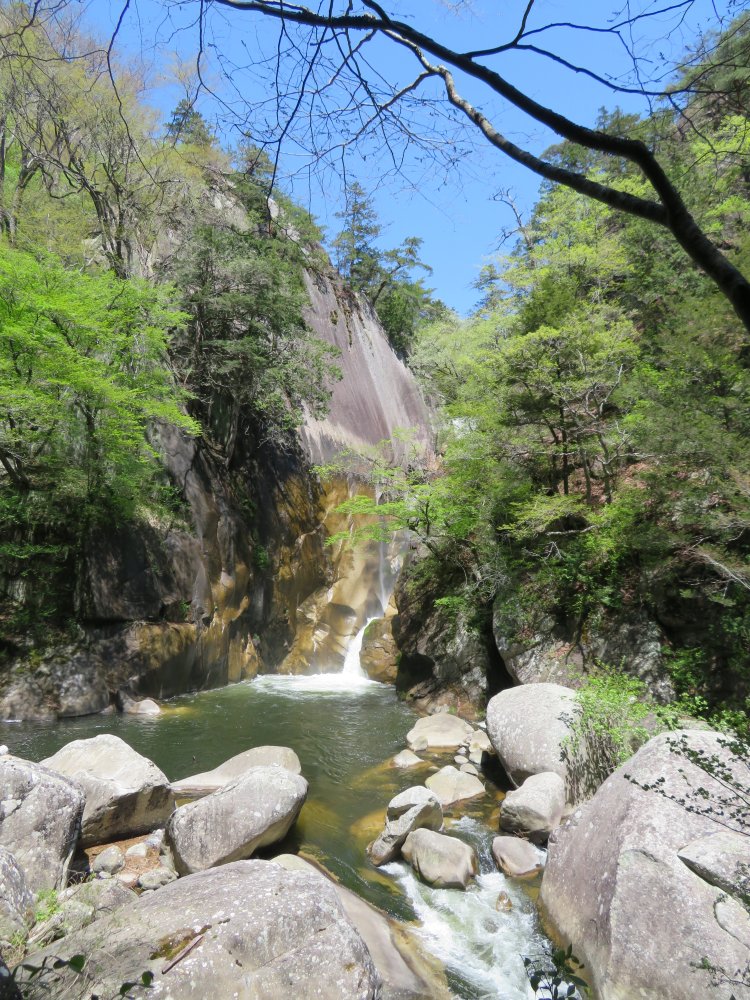
We went to the beautiful Itajiki Valley which stems from the north of Shousenkyou Valley.
I have covered all prefectures in the Kanto region with the exception of Yamanashi Prefecture. I asked some friends from Yamanashi to suggest a good tourist route but excluding Mount Fuji, which is a World Natural Heritage and already a popular tourist location. During the ten-day long 2019 Golden Week, I spent two days following their recommendation. Yamanashi is one of the eight landlocked prefectures of Japan. Eighty per cent of the area is mountainous. It has the sixth smallest population of about 800,000 of which a quarter live in Kofu, the prefectural capital. Historically, the area was called Kai. During Japan’s civil war in the 16th century, the feudal lords of Kai were from the Takeda Family, of which Shingen Takeda is the most known feudal lord particularly for his military strategies. Following my friends’ recommendation, we first visited Minobu-san (Mount Minobu).
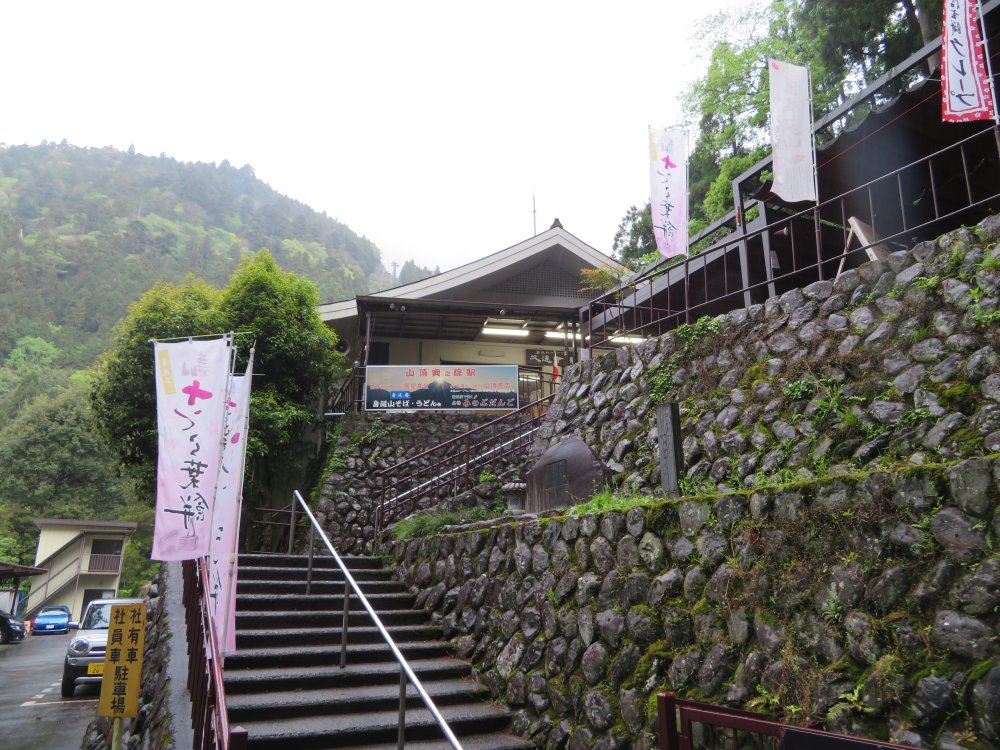
We parked at the car park just below the ropeway station.
Minobusan is known as a sacred place of the Nichiren Buddhist sect where their head temple Kuonji is situated. Nichiren was born in Amatsu-kominato at the southern tip of the Boso Peninsula (Chiba Prefecture). He was convinced that the only way for mankind to achieve peace was to follow the teachings of the Lotus Sutra (Hokkekyou) and started preaching in Kamakura, the then military capital of Japan in the middle of the 13th century. He called for the abandonment of the teachings of the Joudo sect as well as the zen sects for which he was persecuted by the Joudo sect as well as the zen sects revered by the Kamakura military government. He was exiled to Sado Island and on his return invited to Minobusan to teach and pray for peace in 1274, just before the first Mongolian invasion. Kuonji was founded in 1281 at a site to the west and lower level of the present temple grounds relocated in the 15th century. We parked at the car park beside the temple grounds. And entered the main temple grounds. We first took a peek of the steep 287 stairs from the Sanmon gate at the lower level which was the proper route to the temple ground level.
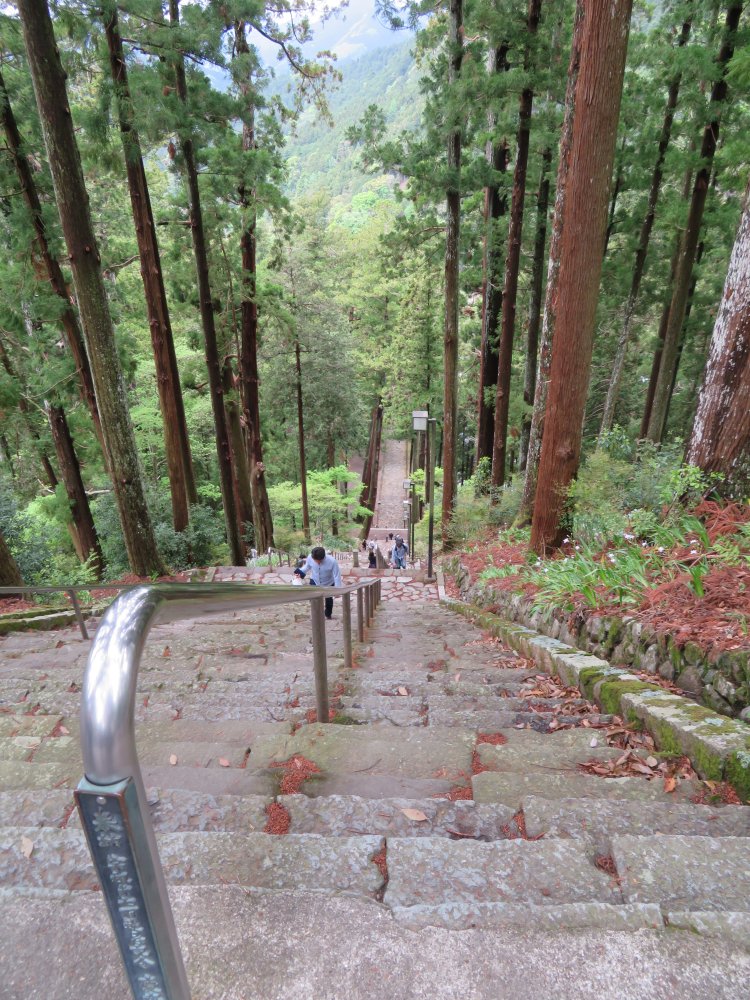
We first took a peek of the steep 287 stairs from the Sanmon gate at the lower level which is the proper route to the temple ground level.
We entered the main temple (Hondou) which is linked to the Soshi-dou. The current Hondou was completed in 1985 after 110 years since it was lost in the fire of 1875. The Soshi-dou which is dedicated to the founder Nichiren was rebuilt much earlier in 1881. It was the first day of Reiwa under the new Emperor and a special prayer was being given in the Soshi-dou when we arrived.
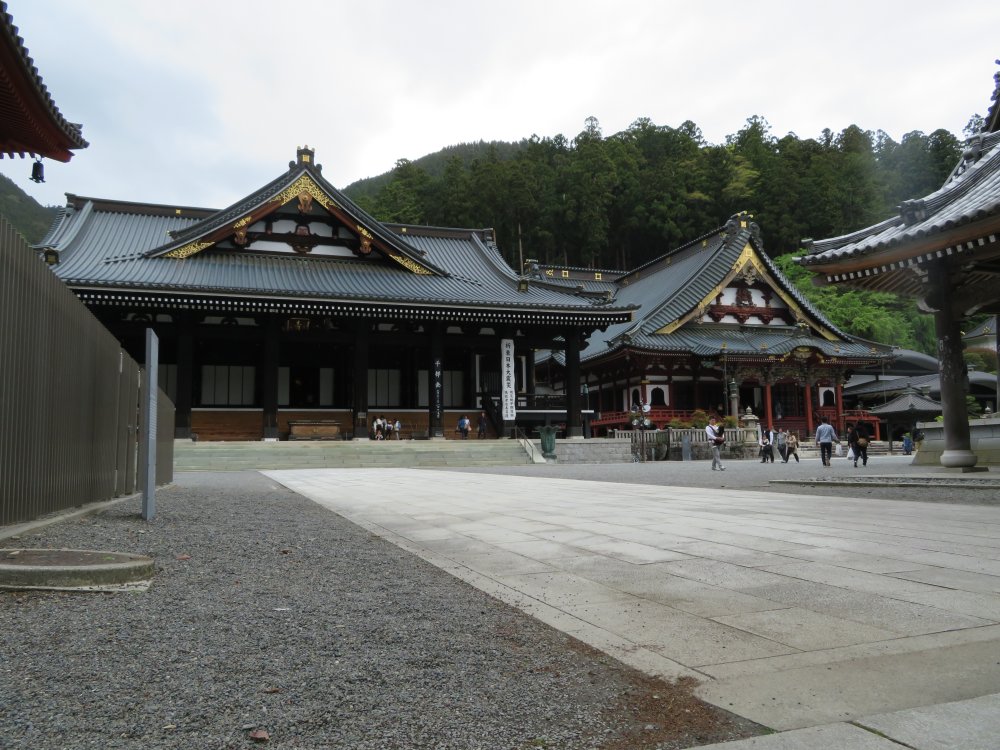
The Hondou (main temple) is linked to the Soshidou on the right dedicated to the founder Nichiren. The present Soshidou was rebuilt in 1881.
I took a moment to browse the grounds and marvel at the five-story pagoda lost in the fire of 1875 and rebuilt after 133 years in 2008. I was quite impressed by the grandness of the temple buildings of the Nichiren sect’s head temple.
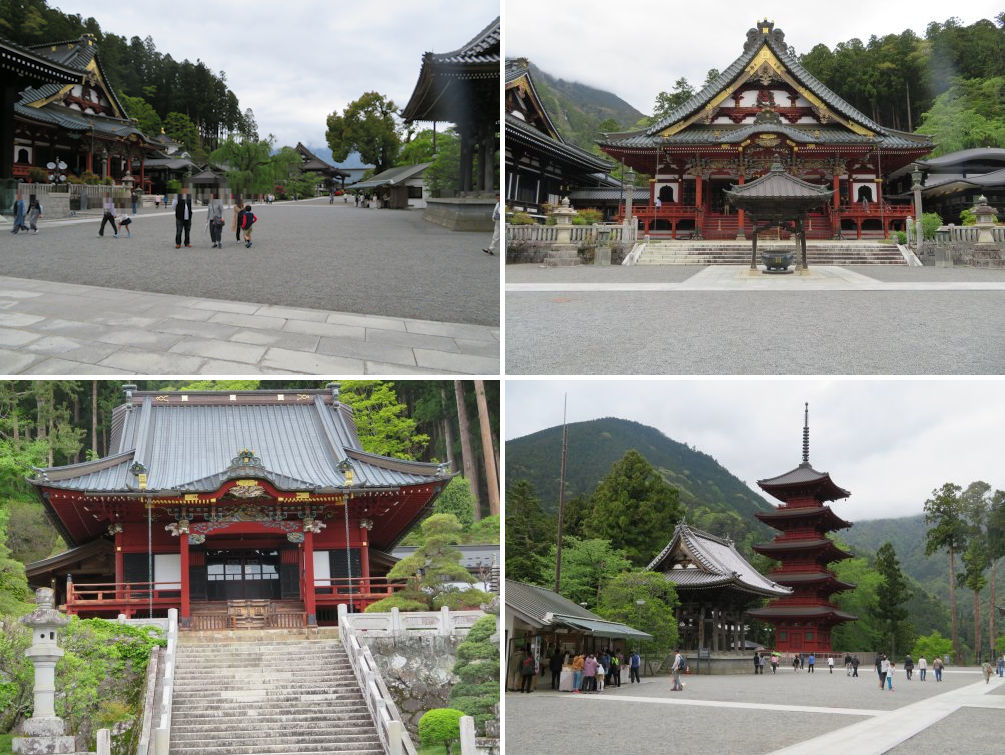
The temple grounds from beside the Hondou (upper left), the Soshidou (upper right), Nichiren's ashes hall (Goshinkotsudou) (lower left) and the five story pagoda (lower right).
From the temple grounds it is a short walk to the bottom station of the ropeway. The ropeway climbs 763 meters in seven minutes to the mountain top at an altitude of 1,153 meters. It had started to rain at the main temple level and as we went up, we entered a thick mist and visibility dropped to almost zero. We had taken the ropeway to visit Shishinkaku. This is also a temple dedicated to Nichiren on top of the mountain where he climbed, looked towards the Boso Peninsula where he was born and mourned for his deceased parents. We barely managed to make out the building. The round trip for the ropeway is 1,400 yen, but we subsequently learned you can get a discount if you book on the internet.
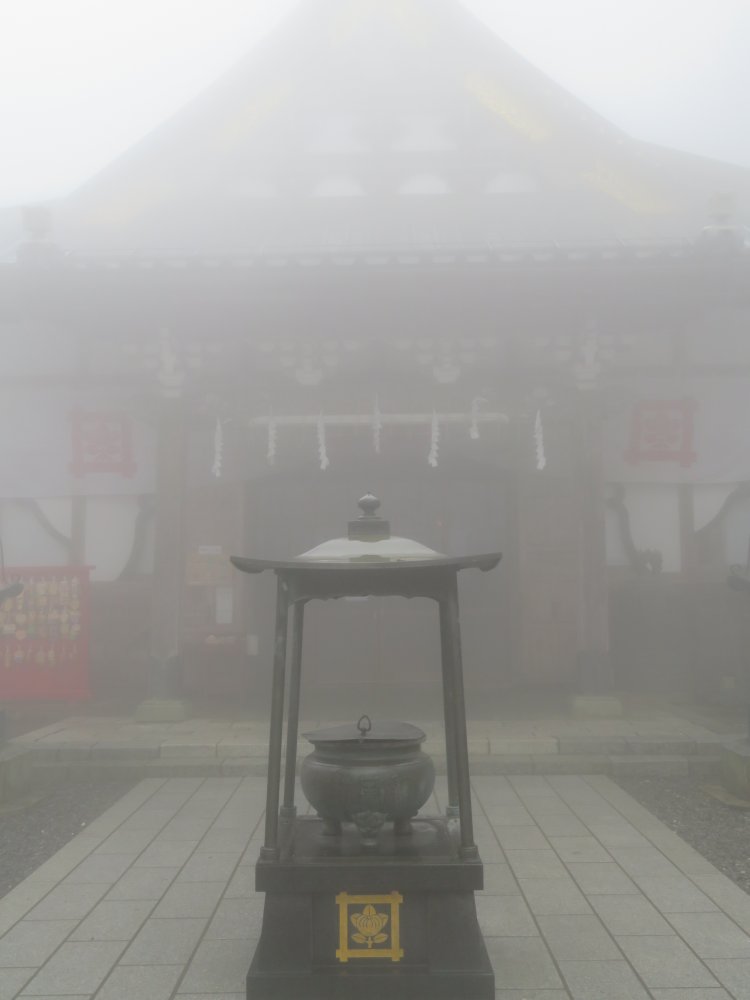
We barely managed to make out the building because of the low visibility.
We descended and went back to the car park. On our way back we briefly
stopped by the Sanmon gate. This is the proper route to visit the temple,
cleansing yourself of three lusts as you go through the gate and be prepared
to enter the sacred grounds. This is an awesome grand wooden gate rebuilt
in 1907. I spent a moment to view the temple grounds from the bottom of
the 287 steps.
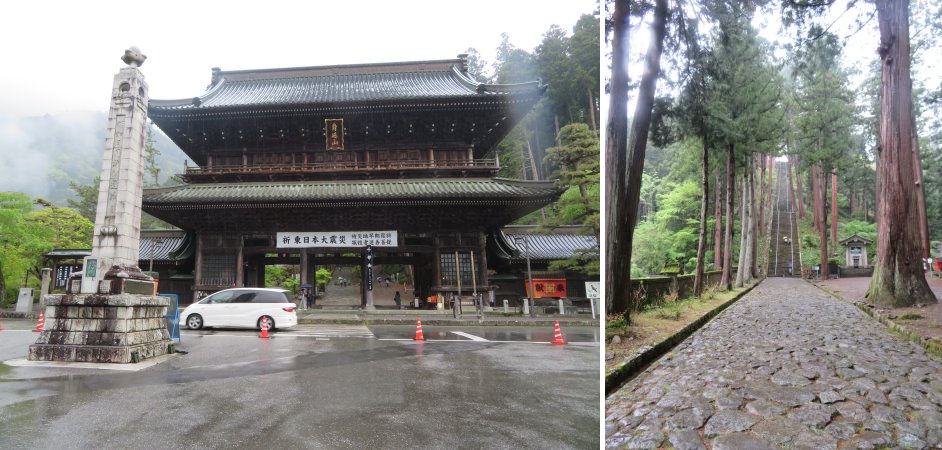
The grand Sanmon gate rebuilt in 1907 (left) and the 287 steps leading up to the temple grounds (right).
We next went to visit the lodging village of Akazawa. About twenty kilometers west of Mount Minobu is a higher mountain Shichimenzan with an altitude of 1,982 meters. At the top of the mountain is the temple Keishin-in, dedicated to Shichimendaimyoujin, the protector of Nichiren sect followers and Minobusan. The lodging village of Akazawa was the lodging place in the middle of the pilgrims’ route between Minobusan and Shichimenzan. I understand there were many lodging houses for the pilgrims but with motorization only one remains in business. It is a very difficult place to visit, as the road is narrow and we struggled to find a safe place to park. Although the area was designated as an Important Preservation District for Groups of Historic Buildings as early as 1993, there are really no facilities or signboards helpful for visitors. We at least managed to find the designation signboard which gave us some information.
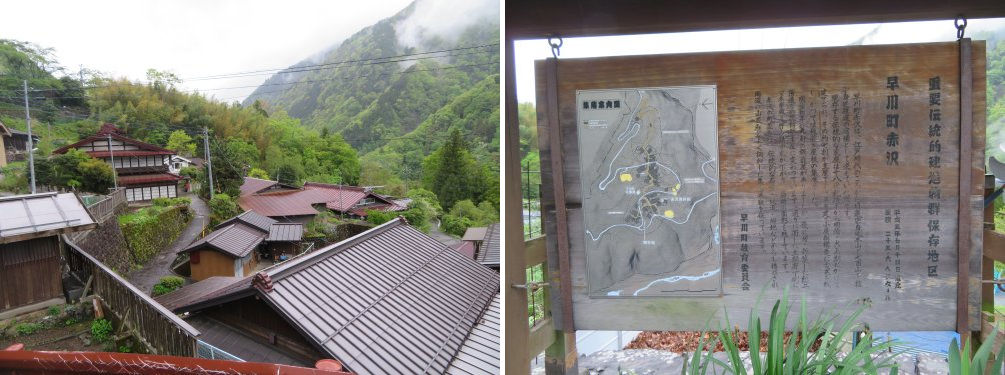
View of the mountain lodging village of Akazawa and the description of Important Preservation District for Groups of Historic Buildings.
The following morning, we first visited Takeda-jinja, a Shinto shrine dedicated to master military strategist and feudal lord, Shingen Takeda. I did not know until this visit that Takeda-jinja is situated on the site of the former Tsutsujigasaki Castle, the head castle of the Takeda Family from 1519 to 1582 when the head castle moved west to Shinpu Castle for a brief period until the fall of the Takeda Family in the same year. Tsutsujigasaki Castle’s use continued a while under the vassals of Hideyoshi Toyotomi who succeeded in reuniting Japan after the civil war, but abandoned at the end of the 16th century upon the completion of Kofu Castle, just west of the present JR Kofu Station. We approached Takeda-jinja from Kofu Station by Takeda-doori (Takeda Avenue) which is a completely straight road. A map at the entrance to Takeda-jinja told us that the residences of the brave Takeda vassals were situated on both sides of the avenue.
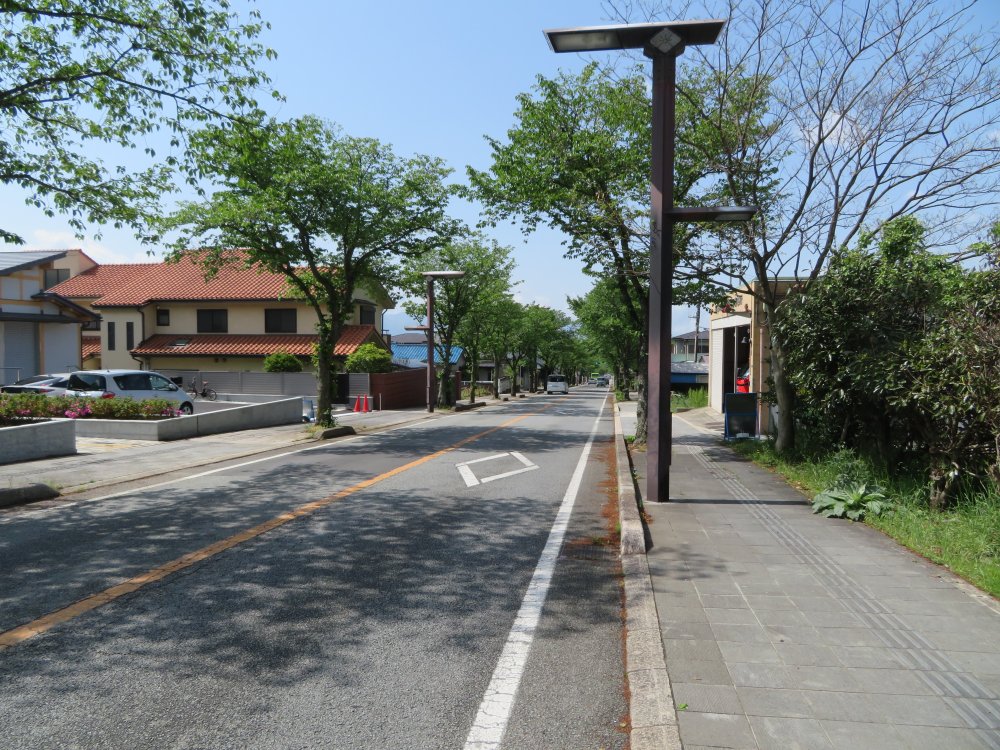
View from Takeda-jinja of the straight street Takeda-doori leading straight to Koufu Station.
Takeda-jinja was founded in 1919 and celebrating its 100-year anniversary this year. It was during the Golden Week and there were quite a few visitors to the shrine.
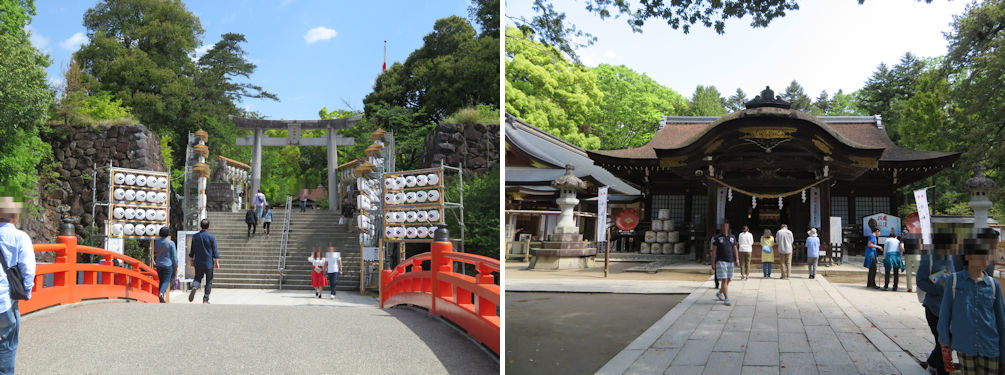
Entrance gate (left) and the main shrine (Honden) area. It was in the middle of a ten-day long Golden Week, and there were quite a few visitors.
We also entered the shrine’s treasure museum which is located to the right of the main shrine. The museum has amassed quite an impressive collection of art, armor, military banners and fans etc. related to the Takeda Family. The admission fee is 300 yen.
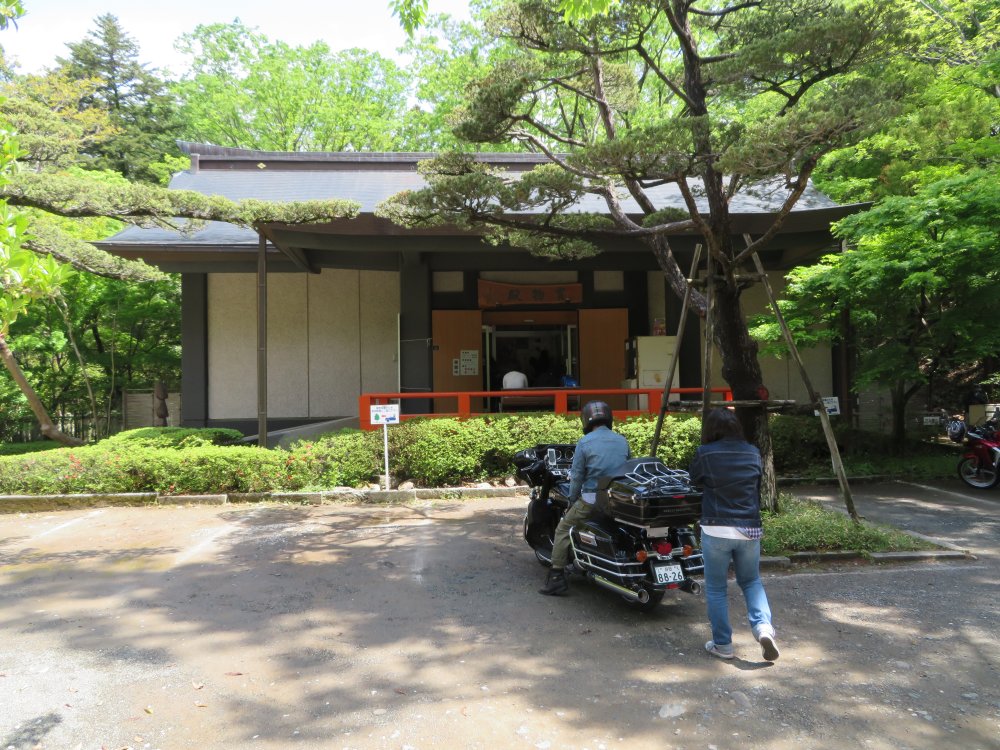
We also entered the shrine’s treasure museum which is located to the right of the main shrine.
We left Takeda-jinja to explore the Shousenkyou Valley. Shousenkyou is a deep valley along the River Arakawa which joins River Fujigawa flowing to the Pacific Ocean created by the erosion of the granite rocks. The valley stretches about ten kilometers upstream from Nagatoro Bridge to Sengataki Waterfalls and Arakawa Dam. It is about thirteen kilometers’ drive north to Nagatoro Bridge from JR Kofu Station. We parked at the municipal free car park close to Sengataki Waterfalls. From the car park it is an easy fifteen minutes’ walk through an alley of gift shops and restaurants and then down to the waterfall. It was sunny and warm, ideal weather to enjoy the walk.
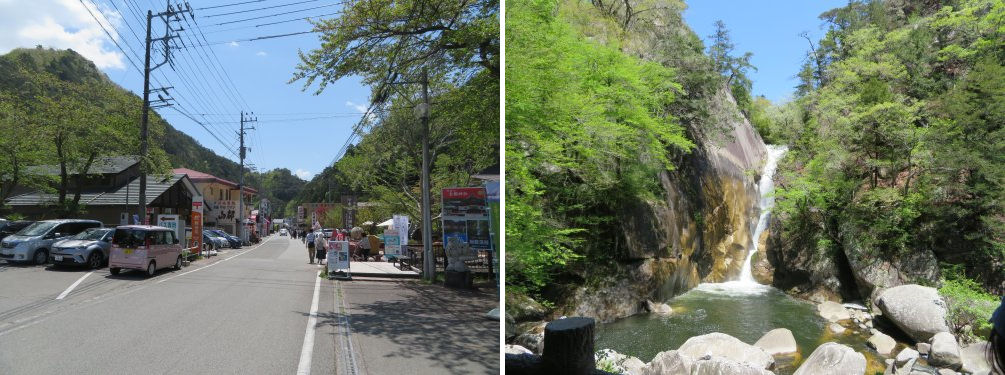
From the car park it is an easy fifteen minutes’ walk through an alley of gift shops and restaurants and then down to the Sengataki Waterfall.
After a quick lunch at a soba restaurant serving hand-kneaded local Mitake Soba, we drove a couple of minutes further upstream to Arakawa Dam. We followed a map we had obtained at the tourist information facility by the municipal car park, to visit another waterfall, Ootaki in the Itajiki Valley that starts from Arakawa dam. Ootaki is a beautiful waterfall and certainly worth visiting if you have the time. It is only a thirty minutes’ excursion from the car park by Arakawa Dam to Ootaki Waterfall.
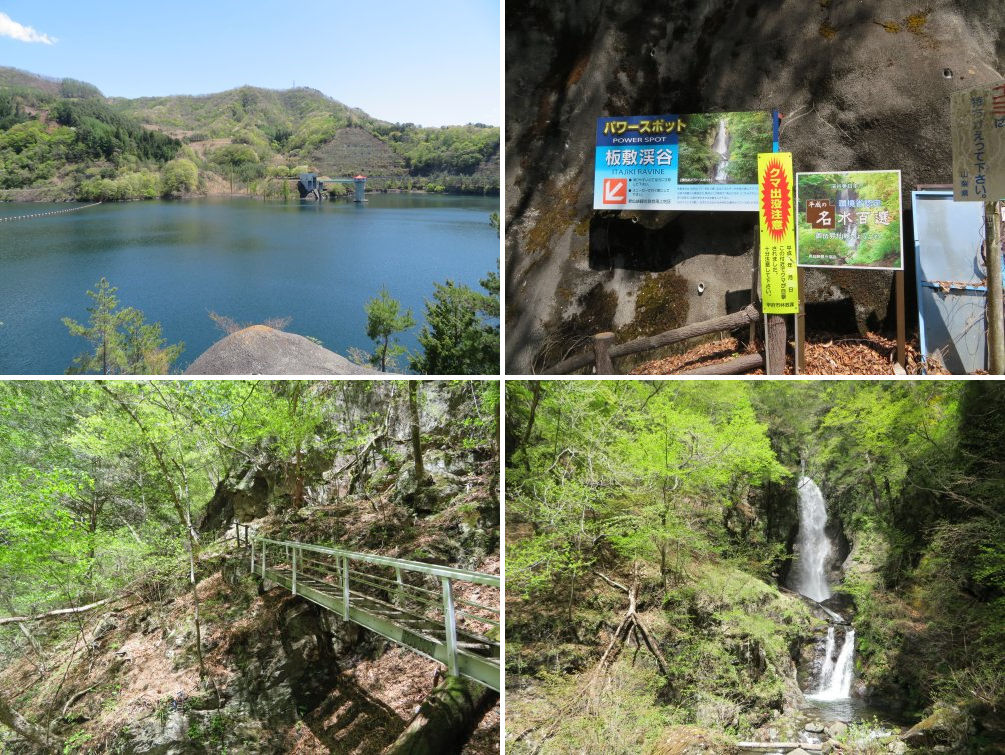
The beautiful Arakawa Dam (upper left), entrance to the Itajiki Valley (upper right). The excursion into Itajiki Valley wasn't that treacherous (lower left). We finally got to Ootaki Waterfalls (lower right).
We then visited two Shinto Shrines situated side by side a couple of minutes away from the dam. One is Meotogi-jinja dedicated to a male deity which is a hundreds of years old tree. This is the partner shrine of Meotogi-himenomiya dedicated to a female deity, located two kilometers lower close to the municipal car park in Shousenkyou Valley. Many visit both shrines to wish for a good marriage and childbirth.
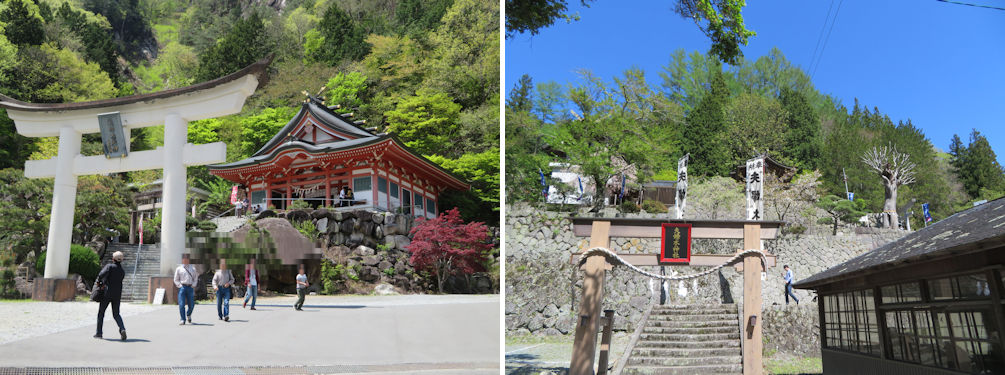
Meotogi-himenomiya (left) and Meotogi-jinja(right).
The other is Kanazakura-jinja. The deity worshipped is Mount Kinpu, a 2,599 meters high mountain at the border of Yamanashi and Nagano Prefectures. The climb to the shrine was so steep I had to leave it for another occasion. One prays for prosperity at this shrine.
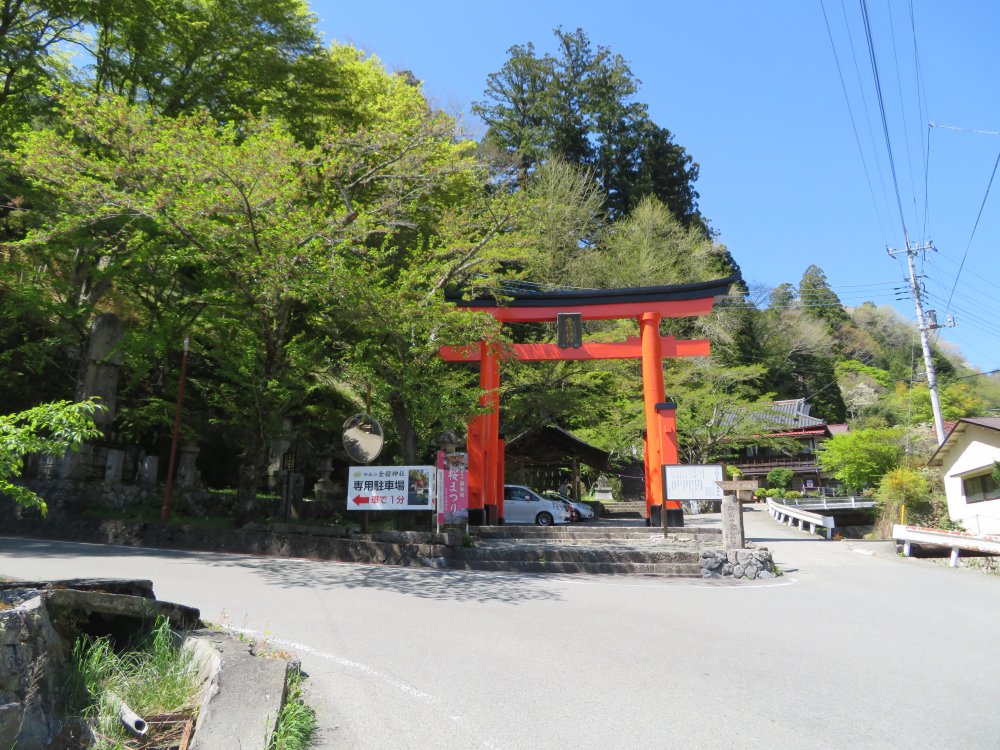
Meotogi-himenomiya (left) and Meotogi-jinja(right).
From Shousenkyou Valley we drove east to our next destination, Erinji Buddhist Temple of the Rinzai zen sect in Koushuu City. There are a couple of must sees in this temple founded in the 14th century which is also the burial place of Shingen Takeda. We paid the admission fee of 300 yen to enter the main temple. It is a worthwhile visit to view the interior of the main temple, and in particular to enjoy the beautiful promenade garden designed by Soseki Musou, a zen high priest and master landscapist that designed the garden of Tenryuuji in Kyoto which has been designated a World Heritage.
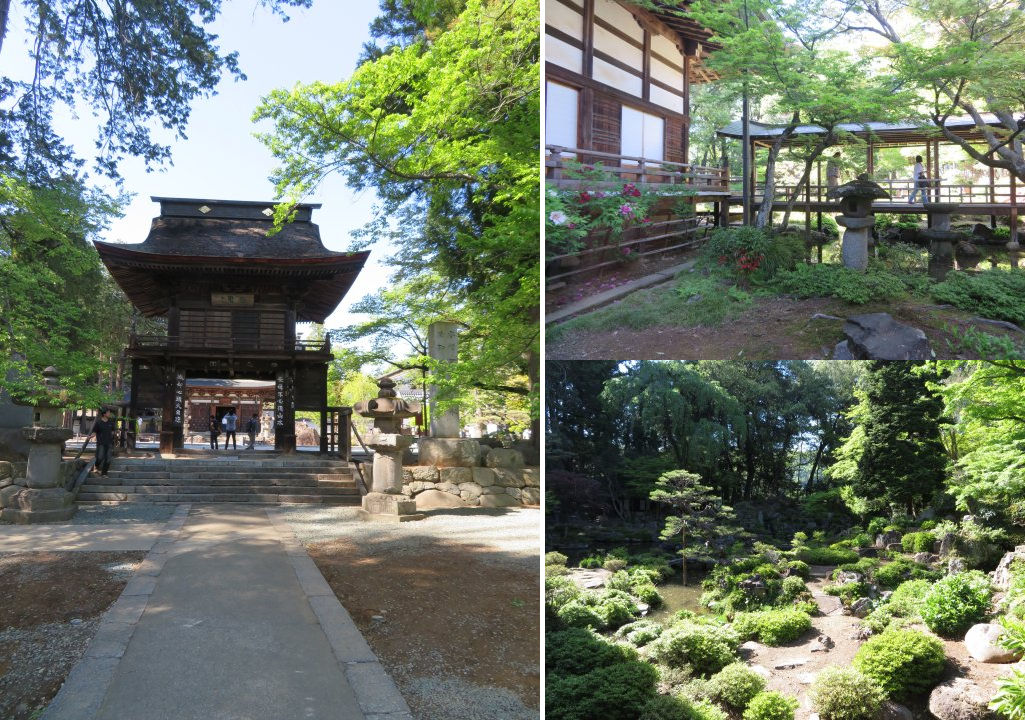
The Sanmon leading to the Kaizandou (left), view from the Butsuden (upper right) and the beautiful promenade garden designed by Soseki Musou, a zen high priest and master landscapist that designed the garden of Tenryuuji in Kyoto which has been designated a World Heritage.
You should not miss the red Shikyakumon (four pillar gate) entry gate to the temple grounds. After the fall of the Takeda Family, Nobunaga Oda’s army set fire to Erinji. This gate was reconstructed by Ieyasu Tokugawa in 1606, and has been designated as a national cultural property.
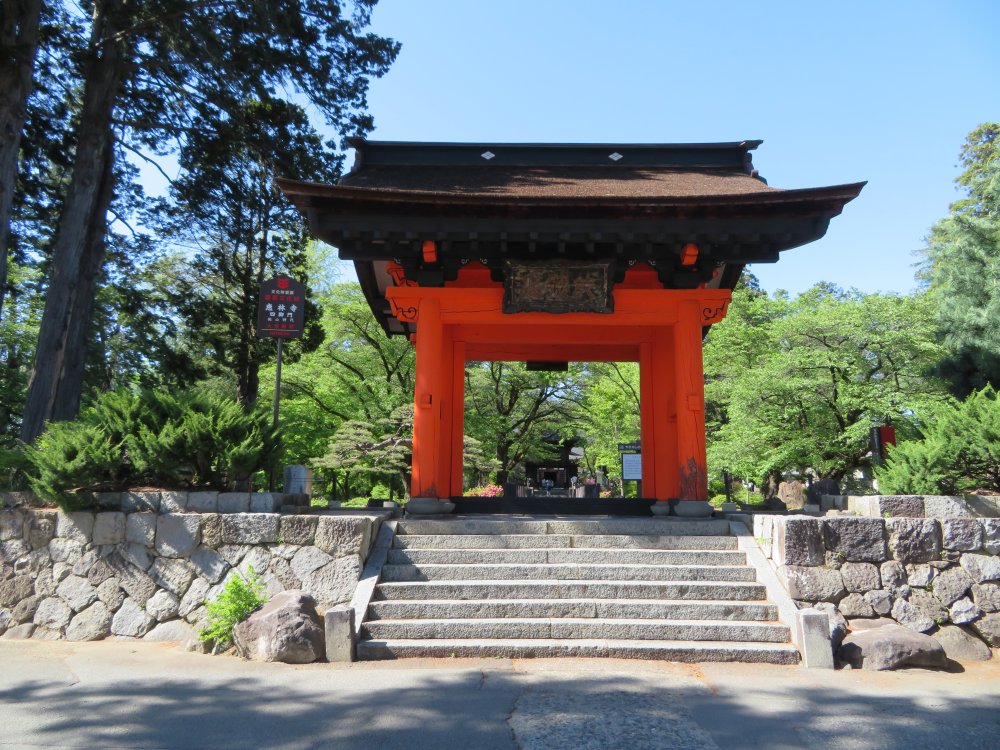
The red Shikyakumon (four pillar gate) entry gate to the temple grounds.
On another occasion we visited Daizenji Buddhist temple of the Shingon sect, on our way back from Chino in Nagano Prefecture to Tokyo. It is located on the eastern side of Katsunuma Town close to Sasago mountain pass, which was the middle point as well as the most treacherous point of the Koushuu Kaidou route from Edo to Shimosuwa. We paid the admission fee of 500 yen per person at the entrance to the car park and received a leaflet together with the admission ticket. According to the leaflet, the temple's history is ancient. They say it was founded in 718 by the high priest Gyouki, the same high priest that engraved the kannonbosatsu of Daifukuji Temple in Tateyama, Chiba Prefecture. Legend says Gyouki saw the Yakushinyorai and his sun and moon servants (Nikkoubosatsu and Gekkoubosatsu) in his dream upon which he founded the temple and engraved the three statues of the holy figures. We went through the sanmon entrance gate rebuilt in 1798 and went up the steep steps to the main temple area. The main temple is called Yakushidou, as it houses the three sacred statues as the main figures of worship. The current building was constructed in 1286. It is the oldest existing building in the Kantou region and has been designated as a National Treasure. The curator gave us a brief introduction to the three statues that are only shown every five years. There are pictures of the statues engraved in the early 13th century by the Buddhist sculptor Renkei. Following the introduction we took a closer look of the many protector statues surrounding the three main statues. I also learned on this occasion that this was where the last Takeda lord, Katsuyori fleeing from the Oda/Tokugawa armies stayed on the last night before commiting suicide at a site further east. It certainly was an interesting and worthwhile visit. The temple provides accommodation as well.
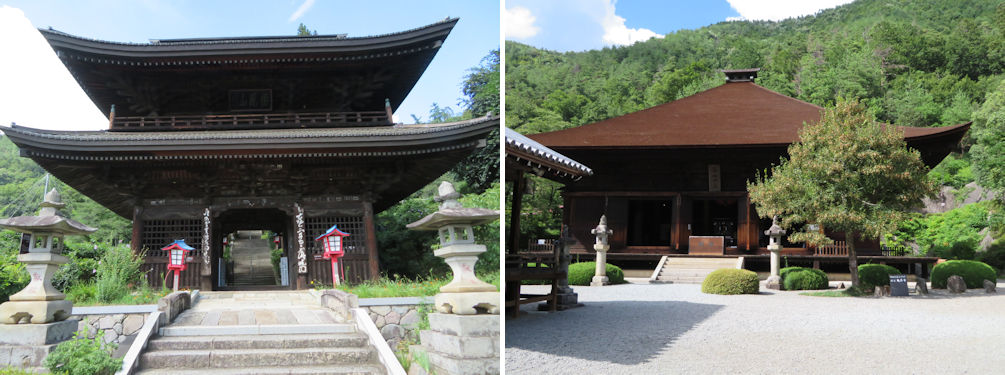
The sanmon entrance gate (left) and the Yakushidou built in 1286 and desiganated a National Treasure (right).
I didn't forget to purchase local sake. I enjoyed the crisp dry taste of Taikan junmai.
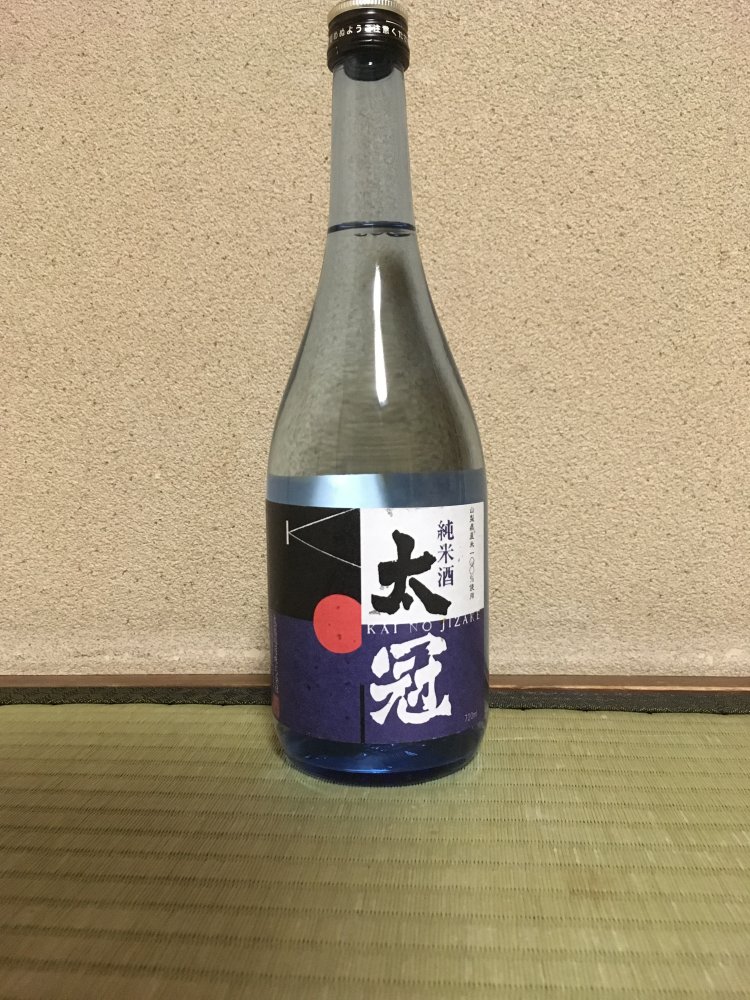
I didn't forget to purchase a local sake, Taikan junmai.